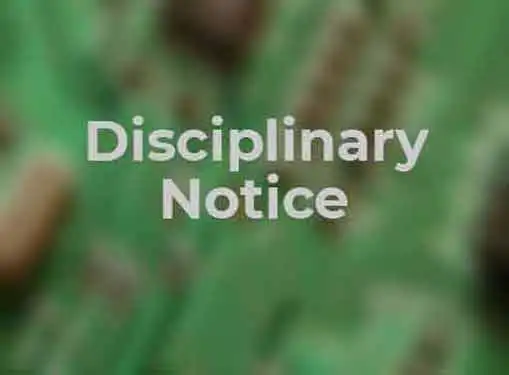Managing Employees
Disciplinary Notice
Employee problems rarely resolve themselves. Sometimes it's necessary to intervene by issuing a disciplinary notice. Here are some things to consider when a disciplinary notice becomes an unavoidable next step.
Effective business leaders create company cultures where the goal of discipline is improvement - not punishment.

You can't allow poor performance or workplace violations to persist, but you need to find a way to leverage discipline as an avenue for helping your employees meet shared goals and objectives.
Standardized disciplinary procedures go a long way toward achieving measurable performance improvements. Although your employee handbook should detail the discipline process, you will also need to develop forms that can be used to document issues and prescribe a course of action for underachieving workers.
Disciplinary notices identify recurring problems in the workplace. If the issue is serious enough, these forms may serve as formal notice of punitive consequences for consistently bad behavior. But more often, disciplinary notices communicate that a recurring performance issue exists and equip the employee with the tools he needs to meet expectations.
- Description of problem. A good disciplinary notice form begins with a description of the problem. This is usually a performance-related issue that has been an ongoing workplace issue. Leave enough room in the section for the supervisor to provide adequate details and to describe specific instances when the problem surfaced.
- Summary of previous disciplinary actions. A disciplinary notice isn't an appropriate vehicle for initially informing an employee that a problem exists. It may be the first formal recognition of a problem, but it's likely that the issue has already been verbally addressed by the individual's supervisor or in annual performance reviews. Summarize any previous conversations that have occurred to document the fact that the issue is recurring.
- Employee requirements. A significant amount of space should be provided for the supervisor and/or HR representative to present the employee with a path for improvement. Additional training, increased focus and a greater time investment are all legitimate requirements that can be included in this section of the discipline notice.
- Consequences (current and future). If the employee has committed a gross violation of company policies, immediate consequences are unavoidable. Otherwise, the consequences section of the form will describe future consequence and deadlines for continued non-performance.
- Signatures. Discipline notices should be signed by the employee, the supervisor and an HR representative (or another individual who can serve as a third-party observer to the discipline process).
Share this article
Additional Resources for Entrepreneurs




Conversation Board
We greatly appreciate any advice you can provide on this topic. Please contribute your insights on this topic so others can benefit.